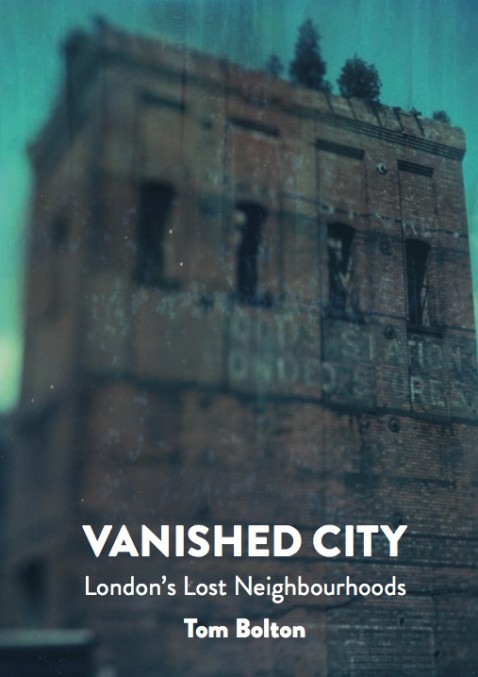Tom Bolton; Vanished City: London’s Lost Neighbourhoods
Strange Attractor, 272 pages, photographs by SF Said, paperback
Review by Ian Rawes
Large cities are as much imagined as experienced by their inhabitants. Memories of places and characters mix with what’s known of the present, like the unofficial hoardings with their layers of torn gig posters, themselves now all but vanished.
Many Londoners seek traces of continuity. An audience always gathers when old photographs and grainy film footage of city life are put online and such interest goes beyond nostalgia since it’s often drawn to times that have slipped from living memory. It overlaps the recent growth in amateur genealogy and for some it must fulfill the same urge to feel part of the living biological stream of generations.
The search for an All Hallow’s Eve where the boundaries between past and present become labile runs throughout Tom Bolton’s impressive new book Vanished City: London’s Lost Neighbourhoods. In it, Bolton resurrects ten such districts through exhaustive research and the kind of occasional dry humour which characterises some of the better recent popular histories, such as Alwyn Turner’s Crisis? What Crisis? Two obvious candidates for the book have been omitted: the great rookery at St Giles and the slum quarter near Westminster Abbey dubbed the Devil’s Acre, which was finally replaced by the huddle of Peabody and Guinness Trust estates south of Victoria Street. But instead of concentrating on central London to the exclusion of all else, Bolton has picked a wider spread, from Old St Pancras in the north to Streatham Spa in the south, and White City in the west to Limehouse in the east.
Each neighbourhood collapsed into obscurity in its own way. We learn how Cripplegate was erased from the City of London during a Blitz firestorm in 1940. Clare Market, where Nell Gwynne once lived and Arthur Machen had browsed secondhand bookshops, became frowzy and impoverished before being ploughed under by the building of Kingsway in the early 1900s. Limehouse’s Chinese population moved away to Soho and elsewhere in the 1960s. The dock streets between Tooley Street and the Thames had an aimless afterlife into the late 20th century before making way for the wind tunnels of the More London development and Norman Foster’s City Hall beer gut. White City vanished piecemeal, with its dog track the last to go, the entrance once flanked by graceful Portland stone greyhounds.
Vanished City is at its most vivid when describing the individuals and communities who lived in these now-liminal places. We meet obscure figures like Thomas Venner, the leader of the Fifth Monarchists cult, and the mudlarks William Smith and Charles Eaton, who made cack-handed forgeries to be passed off as antiquities found at low tide, complete with spelling mistakes (both were illiterate). Somehow they escaped prosecution. Better-known names like Dan Leno, Alexander Pope and Joseph Grimaldi also appear and Bolton’s marshalling of information gives their lives precise geographical context. Bolton reserves short shrift for the writer Thomas Burke, sometimes needy and indiscriminately friendly in his other London writings, here nailed as ‘absurdly melodramatic’ in his accounts of the East End’s Chinese in Limehouse Nights.
Bolton is sympathetic towards the beleaguered Chinese of Limehouse and other marginal communities, noting the snobbery heaped onto the modest and often self-built homes of Agar Town in St Pancras. There are also flashes of scepticism about large-scale planning and a sense that he distinguishes between what’s rational and what’s reasonable. When he seems grudgingly affectionate towards the Barbican Centre, you suspect it’s partly because the navigation aids of colour-coded lines rarely work as envisaged.
Unlike Bolton’s London’s Lost Rivers published in 2011, Vanished City doesn’t seem meant as a walking guide. There are no maps, which I think is the book’s only lack, especially as the best way to read it may be to alternate between digesting some of the chapters and visiting the places described. Once again he has collaborated with the photographer SF Said to good effect. Bluish like the sun-scoured pictures of hairstyle models in barbershop windows, Said’s photographs convey a twilight where time becomes blurred.
This is a fine addition to the canon of London histories, and with it you can explore in the company of one of the city’s most knowledgeable guides.
——————————————————————————————————————————–
Vanished City: London’s Lost Neighbourhoods is available in the Caught by the River shop, priced £11.99
Tom Bolton will be in conversation with Ian Rawes at the next Caught by the River Social Club on 2nd February.
